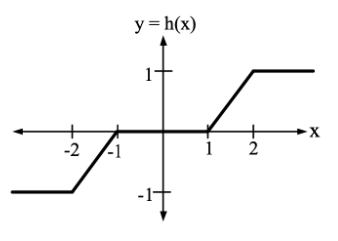A random variable $\mathrm{X}$, distributed normally as $\mathrm{N(0,1)}$ undergoes the transformation
$\mathrm{Y}=\mathrm{h}(\mathrm{X})$, given in the figure. The form of the probability density function of $\mathrm{Y}$ is
(In the options given below, $a, b, c$ are non-zero constants and $g(y)$ is piece-wise continuous function).

- $a \delta(y-1)+b \delta(y+1)+g(y)$
- $a \delta(y+1)+b \delta(y)+c \delta(y-1)+g(y)$
- $a \delta(y+2)+b \delta(y)+c \delta(y-2)+g(y)$
- $a \delta(y+2)+b \delta(y-2)+g(y)$